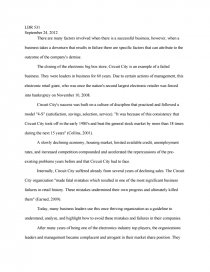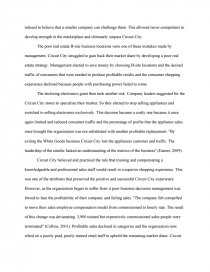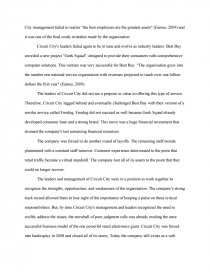The Outcome of the Company's Demise
Essay by jasminecirujeda • February 17, 2013 • Essay • 889 Words (4 Pages) • 1,973 Views
LDR 531
September 24, 2012
There are many factors involved when there is a successful business, however, when a business takes a downturn that results in failure there are specific factors that can attribute to the outcome of the company's demise.
The closing of the electronic big box store, Circuit City is an example of a failed business. They were leaders in business for 60 years. Due to certain actions of management, this electronic retail giant, who was once the nation's second largest electronic retailer was forced into bankruptcy on November 10, 2008.
Circuit City's success was built on a culture of discipline that practiced and followed a model "4-S" (satisfaction, savings, selection, service). "It was because of this consistency that Circuit City took off in the early 1980's and beat the general stock market by more than 18 times during the next 15 years" (Collins, 2001).
A slowly declining economy, housing market, limited available credit, unemployment rates, and increased competition compounded and accelerated the repercussions of the pre-existing problems years before and that Circuit City had to face.
Internally, Circuit City suffered already from several years of declining sales. The Circuit City organization "made fatal mistakes which resulted in one of the most significant business failures in retail history. These mistakes undermined their own progress and ultimately killed them" (Earned, 2009).
Today, many business leaders use this once thriving organization as a guideline to understand, analyze, and highlight how to avoid these mistakes and failures in their companies.
After many years of being one of the electronics industry top players, the organizations leaders and management became complacent and arrogant in their market share position. They refused to believe that a smaller company can challenge them. This allowed never competitors to develop strength in the marketplace and ultimately surpass Circuit City.
The poor real estate B-site business locations were one of these mistakes made by management. Circuit City struggled to gain back their market share by developing a poor real estate strategy. Management elected to save money by choosing B-site locations and the desired traffic of consumers that were needed to produce profitable results and the consumer shopping experience declined because people with purchasing power failed to come.
The declining electronics giant then took another risk. Company leaders suggested for the Circuit City stores to specialize their market. So they elected to stop selling appliances and switched to selling electronics exclusively. This decision became a costly one because it once again limited and reduced consumer traffic and the percentage of profits that the appliance sales once brought the organization was not substituted with another profitable replacement. "By exiting the White Goods
...
...



